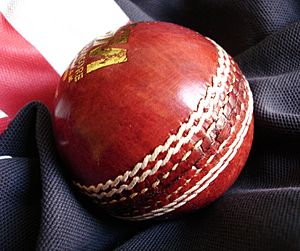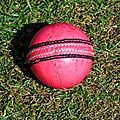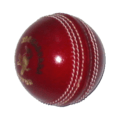Cricket ball facts for kids
A cricket ball is a hard, solid ball used to play cricket. It's super important for the game!
Contents
How Cricket Balls Are Made
Cricket balls have a special design. They start with a core made of cork. This cork core is then wrapped tightly with string. Finally, it's covered with a leather case.
The leather cover is made from four pieces. These pieces are shaped a bit like orange peels. They are stitched together to form a raised seam around the middle of the ball. This seam has six rows of stitches. The other two joins on the ball are left unstitched.
Ball Sizes and Colors
Cricket balls have specific sizes and weights. For men's cricket, a ball must weigh between 155.9 and 163.0 grams. It also needs to be between 224 and 229 millimeters around (its circumference). Balls for women's and youth matches are a little smaller.
Traditionally, cricket balls are red. Red balls are used in long matches like Test cricket. But white balls are also common now. They were first used when games started being played at night under bright lights. White balls are much easier to see at night. Many one-day matches use white balls today.
Sometimes, people have tried other colors like yellow or orange. These colors were tested to see if they would be even better for night games. However, these balls didn't wear down properly during play. This made them not suitable for professional games. White balls tend to swing more at the start of a game and wear out faster than red balls.
How the Ball Changes During a Game
At the start of every game, a brand new, shiny ball is used. But a single ball is used for a long time! As the game goes on, the ball gets older and rougher.
When a Ball Can Be Replaced
A cricket ball can only be replaced in certain situations:
- If the ball gets damaged or lost during play.
- If a player changes the ball's condition in an illegal way.
- After a certain number of overs have been bowled. In Test cricket, this is 80 overs. The captain of the bowling team can then choose to get a new ball.
If a ball is hit into the crowd, it's not replaced. The crowd has to throw it back! If a ball is damaged, lost, or illegally changed, it's replaced with a used ball. This replacement ball will be in a similar condition to the one that was taken out. A new ball can only be used after the required number of overs have been bowled with the old one.
Keeping the Ball in Good Shape
Because the ball gets rough, bowlers often polish it. They usually rub it on their trousers. This is why you might see red stains on their clothes! Bowlers usually only polish one side of the ball. This helps them make the ball swing in the air. They can use natural things like saliva or sweat to polish the ball. But using any other material is against the rules.
The seam of the ball is also very important. Bowlers can use it to make the ball move in different ways. This is called swing bowling (moving in the air) or seam bowling (moving after it bounces).
Rules for Ball Condition
The condition of the ball is super important for how bowlers play. Because of this, there are strict rules about what players can and cannot do to the ball. The umpires check the ball often during a match.
It is against the rules for a player to:
- Rub anything on the ball except saliva or sweat.
- Rub the ball on the ground.
- Scratch the ball with anything rough, like fingernails.
- Pick at or lift the seam of the ball.
Breaking these rules to gain an advantage is called ball tampering. It's a serious offense in cricket.
How Ball Age Affects Play
A new cricket ball is harder and bouncier. This makes it great for fast bowlers. They like the speed and bounce it gets off the pitch.
Older balls are rougher. This roughness helps them grip the pitch more when they bounce. So, spin bowlers often prefer to use a worn ball. Uneven wear on older balls can also help create a special kind of swing called reverse swing. A captain might wait to ask for a new ball if they want their spin bowlers to play more. But usually, they ask for a new ball as soon as they can.
Cricket balls are very hard. They can be dangerous if someone gets hit. That's why players like batsmen and close fielders wear protective helmets and gear today.
Other Types of Cricket Balls
Sometimes, people use different kinds of balls instead of a real cricket ball. This might be for safety, practice, or because they are cheaper.
- A common alternative is a tennis ball.
- There are also plastic versions of cricket balls, sometimes called Incrediballs.
Many casual players use a tennis ball wrapped in layers of adhesive tape. This makes the soft tennis ball harder and smoother.
Images for kids










